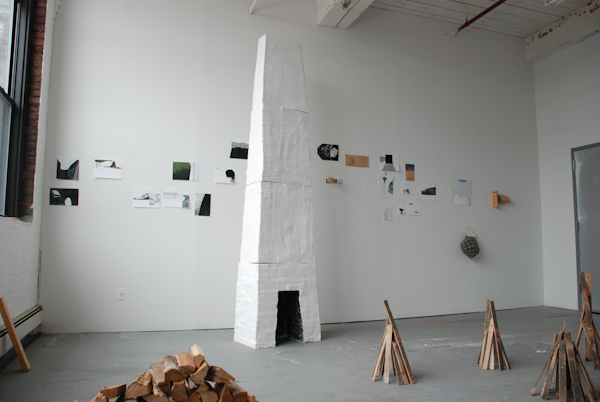NAME: Abraham McNally
STUDIO LOCATION: 94 9th Street, Gowanus, 4th Floor, #12
TIME IN BROOKLYN: 12 years
SHARED STUDIO: No
[Editors’ Note: This coming weekend, we’ll be touring Brooklyn for GO Open Studios, an event in which visitors vote on which artist they feel deserves to get an exhibition at the Brooklyn Museum. As a service to both ourselves and other readers, we’ve scoured the event’s pages for the most promising studios and then sent those artists an email with a few questions about their work. The following posts relay what they told us.]
In the early 70s, Abraham McNally’s father started a farm on five acres of land in Vermont. McNally’s structures reflect the one-room cabin that his father built there, because a lot of them are also encasements made from rustic building materials: a shed stuffed with firewood; a teepee made of logs; what look like brick and plaster chimneys.
Where are you from? What’s your background?
I’m from a rural area in Vermont called the Northeast Kingdom.
Are you showing your work in galleries?
I’ll have work in three shows this fall:
BRIC Rotunda Gallery, 8 Artists Making Sculpture, Brooklyn NY
Radiator Arts, This is How My Brain Works, Long Island City, NY
111 Front Street, Speakers DUMBO, Brooklyn, NY
Why are you participating in GO?
I’m curious to see who turns up, especially people who don’t usually see the inside of artists’ studios.
Did you live on the Vermont commune with your father? Was it a commune? What was your experience?
In 1973 my father bought 5 acres of overgrown pasture in rural northern Vermont. He camped on the land as he cut a small building site out of the woods. He designed and built the one room cabin that I spent my early childhood in.
He was a back-to-the-land hippie deeply committed to the culture of the 1960’s hope of rejecting American suburban conformity, consumerism, and abundance. With these beliefs came a romantic return to the rural, the farm, and the land. However, his community was unable to sustain a life with its own hands. In reality, splitting wood, milking a cow, or identifying what a potato plant looks like proved difficult for the sons and daughters of suburban affluence. As I grew up, I watched as my father and his peers slowly realized that a return to the comforts and realities of American society was inevitable.
You work with architecture. If you had a limitless budget, what would you make?
A tree house!
You talk about architecture as a “container for memory,” often containing things like wood, hay bales, fabric, and charcoal. You mean a simpler past? Your past? Do you feel we’ve moved beyond materials like these?
I hope we haven’t moved beyond these materials. I do think that they have become unfamiliar and foreign in a lot of communities. I find myself and my viewers respond to these materials because they speak to a very direct way of interacting with the objects in your environment.



{ 1 comment }
“Container for memory.” Love it. Wish I could get there for the Open Studio Weekend. http://esotericsynapticevents.blogspot.com
Comments on this entry are closed.